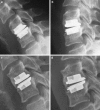Clinical results and development of heterotopic ossification in total cervical disc replacement during a 4-year follow-up
- PMID: 20035357
- PMCID: PMC2899807
- DOI: 10.1007/s00586-009-1259-3
Clinical results and development of heterotopic ossification in total cervical disc replacement during a 4-year follow-up
Abstract
Cervical total disc replacement (CTDR) aims to decrease the incidence of adjacent segment disease through motion preservation in the operated disc space. Ongoing data collection and increasing number of studies describing heterotopic ossification (HO) resulting in decreased mobility of implants, forced us to carefully evaluate our long-term clinical and morphological results of patients with CTDR. We present the first 54 consecutive patients treated with 65 ProdiscC prostheses during a 12-month period (2/2004-3/2005). All patients signed an informed consent and were included in prospective long-term study approved by hospital ethical committee. The 1- and 2-year follow-up analysis were available for all patients included and 4-year results for 50 patients (60 implants). Clinical (neck disability index-NDI, visual analog scale-VAS) and radiological follow-up was conducted at 1-, 2- and 4-years after the procedure. The Mehren/Suchomel modification of McAfee scale was used to classify the appearance of HO. Mean preoperative NDI was 34.5%, VAS for neck pain intensity 4.6 and VAS for arm pain intensity 5.0. At 1-, 2- and 4-year follow-up, the mean NDI was 30.7, 27.2, and 30.4, mean VAS for neck pain intensity 2.5, 2.1 and 2.9 and mean VAS for arm pain intensity pain 2.2, 1.9 and 2.3, respectively. Significant HO (grade III) was present in 45% of implants and segmental ankylosis (grade IV) in another 18% 4 years after intervention. This finding had no clinical consequences and 92% of patients would undergo the same surgery again. Our clinical results (NDI, VAS) are comparable with fusion techniques. Although, advanced non-fusion technology is used, a significant frequency of HO formation and spontaneous fusion in cervical disc replacement surgery must be anticipated during long-term follow-up.
Figures








Similar articles
-
Four-year results of a prospective single-arm study on 200 semi-constrained total cervical disc prostheses: clinical and radiographic outcome.J Neurosurg Spine. 2016 Nov;25(5):556-565. doi: 10.3171/2016.3.SPINE15810. Epub 2016 Jun 3. J Neurosurg Spine. 2016. PMID: 27258476 Clinical Trial.
-
Clinical and radiological analysis of Bryan cervical disc arthroplasty: eight-year follow-up results compared with anterior cervical discectomy and fusion.Int Orthop. 2016 Jun;40(6):1197-203. doi: 10.1007/s00264-015-3098-7. Epub 2016 Jan 7. Int Orthop. 2016. PMID: 26744166
-
Clinical and radiological outcome at 10 years of follow-up after total cervical disc replacement.Eur Spine J. 2017 Sep;26(9):2441-2449. doi: 10.1007/s00586-017-5204-6. Epub 2017 Jul 4. Eur Spine J. 2017. PMID: 28676980
-
A comparison study between hybrid surgery and anterior cervical discectomy and fusion for the treatment of multilevel cervical spondylosis.Bone Joint J. 2020 Aug;102-B(8):981-996. doi: 10.1302/0301-620X.102B8.BJJ-2019-1666.R1. Bone Joint J. 2020. PMID: 32731832
-
High prevalence of heterotopic ossification after cervical disc arthroplasty: outcome and intraoperative findings following explantation of 22 cervical disc prostheses.J Neurosurg Spine. 2012 Aug;17(2):141-6. doi: 10.3171/2012.4.SPINE12223. Epub 2012 Jun 1. J Neurosurg Spine. 2012. PMID: 22657947 Review.
Cited by
-
Total disc replacement in the cervical spine: a systematic review evaluating long-term safety.Evid Based Spine Care J. 2012 Feb;3(S1):9-18. doi: 10.1055/s-0031-1298604. Evid Based Spine Care J. 2012. PMID: 23236309 Free PMC article.
-
Quality of Life Following Prestige LP Cervical Disc Arthroplasty in a Prospective Multicountry Study.Int J Spine Surg. 2019 Jun 30;13(3):221-229. doi: 10.14444/6030. eCollection 2019 Jun. Int J Spine Surg. 2019. PMID: 31328085 Free PMC article.
-
Mechanical Stability of the Prodisc-C Vivo Cervical Disc Arthroplasty: A Preliminary, Observational Study Using Radiostereometric Analysis.Global Spine J. 2020 May;10(3):294-302. doi: 10.1177/2192568219850763. Epub 2019 May 23. Global Spine J. 2020. PMID: 32313795 Free PMC article.
-
Footprint mismatch in total cervical disc arthroplasty.Eur Spine J. 2013 Apr;22(4):759-65. doi: 10.1007/s00586-012-2594-3. Epub 2012 Nov 27. Eur Spine J. 2013. PMID: 23184184 Free PMC article.
-
Cervical Disc Arthroplasty: A Comprehensive Review of Single-Level, Multilevel, and Hybrid Procedures.Global Spine J. 2018 Feb;8(1):78-83. doi: 10.1177/2192568217701095. Epub 2017 May 16. Global Spine J. 2018. PMID: 29456918 Free PMC article. Review.
References
-
- Baba H, Furusawa N, Imura S, Kawahara N, Tsuchiya H, Tomita K. Late radiographic findings after anterior cervical fusion for spondylotic myeloradiculopathy. Spine (Phila Pa 1976) 1993;18:2167–2173. - PubMed
-
- Bertagnoli R. Heterotopic ossification at the index level after Prodisc-C surgery: what is the clinical relevance? Spine J. 2008;8:123S. doi: 10.1016/j.spinee.2008.06.687. - DOI
Publication types
MeSH terms
LinkOut - more resources
Full Text Sources
Medical

